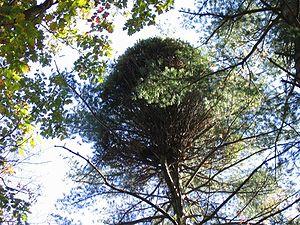
Witch's broom or witches' broom is a deformity in a woody plant, typically a tree, where the natural structure of the plant is changed. A dense mass of shoots grows from a single point, with the resulting structure resembling a broom or a bird's nest. It is sometimes caused by pathogens.
Witch-broom disease, caused by phytoplasmas or basidiomycetes, is economically important in a number of crop plants, including the cocoa tree Theobroma cacao,[1] jujube (Ziziphus jujuba)[2] and the timber tree Melia azedarach.[3]
Causes
A tree's characteristic shape, or habit, is in part the product of auxins, hormones which control the growth of secondary apices. The growth of an offshoot is limited by the auxin, while that of the parent branch is not. In cases of witch's broom, the normal hierarchy of buds is interrupted, and apices grow indiscriminately. This can be caused by cytokinin, a phytohormone which interferes with growth regulation. The phenomenon can also be caused by other organisms, including fungi, oomycetes, insects, mites, nematodes, phytoplasmas, and viruses.[4] The broom growths may last for many years, typically for the life of the host plant. If twigs of witch's brooms are grafted onto normal rootstocks, freak trees result, showing that the attacking organism has changed the inherited growth pattern of the twigs.[4]
Ecological role
Witches' brooms provide nesting habitat for birds and mammals, such as the northern flying squirrel, which nests in them.[5][6]
See also
- Plant development: buds and shoots – atypical shoot development
- Epicormic shoot – a shoot that develops from buds under the bark
- Forest pathology
- Longan witches broom-associated virus
- Melampsora can cause different kinds of witch's brooms.
- Moniliophthora perniciosa, cause of witch's broom disease in cacao
- Phyllody, a related plant growth abnormality affecting flowers
References
- ^ Purdy, L.H.; Schmidt, R.A. (1996). "Status Of Cacao Witches' Broom: Biology, Epidemiology, and Management". Annual Review of Phytopathology. 34 (1): 573–594. doi:10.1146/annurev.phyto.34.1.573. PMID 15012557.
- ^ Li Yun; Wang Yu; Tian Yanting & Sun Haoyuan (2001). "Advances in Tissue Culture and Eliminating of the Pathogeny of Witch Broom Disease(MLO) of Chinese Jujube".
- ^ Gomez, G.G.; Conci, L.R.; Ducasse, D.A.; Nome, S.F. (1996). "Purification of the Phytoplasma Associated with China-tree (Melia azedarach L.) Decline and the Production of a Polyclonal Antiserum for its Detection". Journal of Phytopathology. 144 (9–10): 473–477. doi:10.1111/j.1439-0434.1996.tb00327.x.
- ^ a b Book of the British Countryside. Pub. London : Drive Publications, (1973). p. 519.
- ^ Mowry, Robert A. (2008). "Northern Flying Squirrel" (pdf). Alaska Department of Fish and Game. Retrieved 2 June 2020.
- ^ Paragi, Thomas; Rodman, Sue (2020). "Maintaining wildlife habitat in the boreal forest of Alaska" (pdf). Alaska Department of Fish and Game. pp. 18–19. Retrieved 2 June 2020.
External links
![]() Media related to Witch's broom at Wikimedia Commons
Media related to Witch's broom at Wikimedia Commons
- Witches' Broom at BBC h2g2.
- Fir and spruce broom
